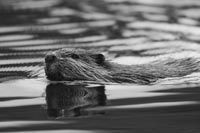Wildlife discussions in the Wood River Valley tend to focus on bears, wolves and elk. But beavers, a keystone species that many riparian-dependant birds and fish rely on to create habitat, are often overlooked until they cause problems for homeowners and trail users.
Beavers are creatures of simple needs, said Kurt Nelson, Ketchum District Ranger for the U.S. Forest Service.
"Where there's willow, aspen, cottonwood and water, that's beaver habitat," he said.
Beavers can be found anywhere there is sufficient dam-building material and flowing water, said Robin Garwood, a wildlife biologist with the Sawtooth National Recreation Area. Almost any water will do, Garwood said, but the stream being dammed can't be flowing too fast or the dams won't hold.
Beavers are notorious for their dams, though Lisa Huttinger, interim director for the Environmental Resource Center and leader of the center's beaver walks, said people often have misconceptions about the dams' purpose.
"People think beavers build dams to get more fish," she said. "Beavers are vegetarians, they don't eat fish!"
Beavers eat grass and bark, but their main food source is cambium, the thin layer of living plant tissue underneath the bark.
"You can find trees that have been taken down where beavers have stripped off all the bark," Huttinger said.
She said that when beavers build dams, they are expanding their food source in a sense, but not in the way most people think.
"Beavers are horrible walkers. They're excellent swimmers," she said. "In the areas where they build dams, they are expanding the food source they can swim to."
While beavers can be found in drainages from Little Redfish Lake to the south valley, no one is sure exactly how many beavers exist in the state. Mike Todd, regional furbearer biologist for the Idaho Department of Fish and Game, said the department stopped tracking the rodents in the early 1990s due to budget constraints.
< "We simply don't have any information regarding population and beaver numbers," he said.
Beavers used to be threatened by the trapping industry, Todd said, but both the number of trappers and the price of beaver have fallen over the past few decades. Now, there are fewer than 1,000 trappers in Idaho.
Beavers are a keystone species, meaning that other species rely on them for habitat. Garwood said that when beavers build dams and create ponds, they create habitat for other species.
"Often these ponds will raise the water table," Garwood said, creating wetlands that provide living space and food sources for hummingbirds, yellow warblers and mallards.
Huttinger said beaver dams allow sediment to build up in certain areas, which allows new plant species to take hold. Moose use riparian areas around beaver ponds, and Huttinger said elk use the beaver pond areas during calving season.
"There's definitely a large ripple effect," she said.
But not everyone is as happy as the ungulates when beavers move into a region.
"Beavers are wonderful, but sometimes they create headaches about where they choose to drop trees," Nelson said.
Nelson said the major areas where the Forest Service struggles with beavers are out Deer Creek north of Hailey and at the Copper Creek campground east of Bellevue. The campground had been recently renovated when beavers began harvesting aspens that fell on newly installed picnic tables.
A large dam complex near Deer Creek raised the water table and washed out a cattle guard, requiring the Forest Service to close the road for more than a month. Nelson said he's been watching a similar complex near the Fox Creek trail north of Ketchum.
"I'm hoping they don't drop a tree on a vehicle or the restroom there," he said.
Garwood said beavers generally are considered a "bane" by most people.
"They basically mess with our infrastructure," she said, by eating trees, washing out roads and plugging culverts. Beaver ponds near homes that raise the water table can even cause septic systems to back up, she said.
Unfortunately, Garwood said, there's not much that can be done to deter a determined beaver.
"If you're in good habitat, it's pretty hard to discourage them," she said. "They are fairly obsessive about keeping their dams functional. If you tear out a dam, it's usually built back in a couple of days."
Beavers will rotate locations as they run out of a food source, moving dams upstream or downstream and leaving more lush vegetation in their path.
Nelson said the Forest Service is developing a plan to move a section of Deer Creek road up the hillside and out of a beaver zone.
Other than that, he said, there's not a lot it can do.
"We try to live trap them and relocate them," he said, adding that despite the damage they do to area trails, he harbors no ill will toward the 40-pound furry rodents.
"They're just doing their thing, moving the river back and forth, building a water storage reserve and creating a lush riparian zone," he said. "They're just being beavers."
Katherine Wutz: kwutz@mtexpress.com


 Beavers, the obsessive-compulsive builders of the animal world, cause headaches for homeowners but are a boon to species that depend on beaver ponds for habitat.
Metro Creative photo
Beavers, the obsessive-compulsive builders of the animal world, cause headaches for homeowners but are a boon to species that depend on beaver ponds for habitat.
Metro Creative photo



































